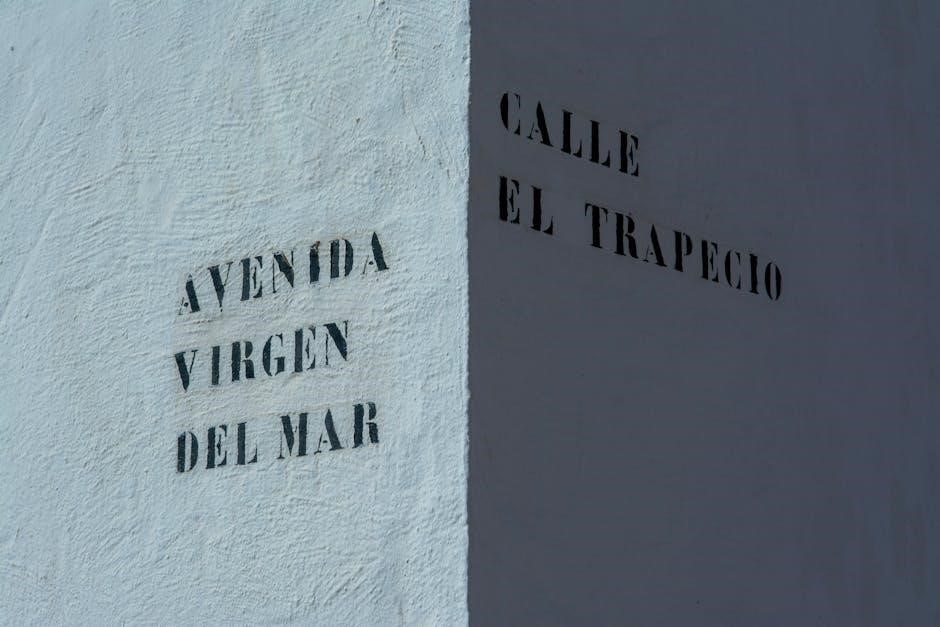Spanish short stories, particularly those around , offer concise yet impactful narratives, making them accessible in PDF formats for readers seeking cultural insights and linguistic enrichment.

1.1 The Significance of Short Stories in Spanish Literature
Spanish short stories hold immense cultural and literary value, capturing the essence of identity, social issues, and historical contexts. They provide a concise yet profound reflection of society, making them essential for understanding Spanish-speaking cultures. These narratives often explore themes of identity, tradition, and modernity, offering insights into the human condition. Their brevity allows for focused storytelling, making them accessible to a wide audience. Additionally, short stories in PDF formats, such as the 1000-word tales, have become popular for their portability and ease of access, enabling readers to engage with Spanish literature anywhere, anytime. This format also supports language learning and cultural immersion.
1.2 The Popularity of 1000-Word Spanish Short Stories
The 1000-word Spanish short story has gained significant popularity due to its concise yet impactful nature, allowing readers to engage deeply without committing to longer works. This length is ideal for exploring complex themes like identity, love, and social issues, making it a favorite among both writers and readers. PDF formats have further boosted accessibility, enabling easy sharing and reading on digital devices. Additionally, competitions like “Concurso de El Cuento de las 1,000 Palabras” have incentivized authors to craft compelling stories within this word limit, fostering creativity and innovation in Spanish literature. As a result, these stories are widely consumed and admired globally.
1.3 The Role of PDF Formats in Accessing Spanish Short Stories
PDF formats have revolutionized access to Spanish short stories, offering a convenient and portable way to enjoy literature. Readers can easily download and store these files on devices, ensuring stories are available anytime, anywhere. The fixed layout of PDFs preserves the author’s formatting, enhancing the reading experience. Many websites and online archives provide free access to Spanish short stories in PDF, making them accessible to a global audience. This format is particularly valuable for educational purposes, as it allows learners to study and reference stories without needing physical copies. The rise of digital platforms has further amplified the reach and popularity of Spanish short stories in PDF format.

Cultural and Social Relevance of Spanish Short Stories
Spanish short stories provide profound insights into cultural identity, social traditions, and contemporary issues, making them a vital reflection of society and human experiences.
2.1 How Spanish Short Stories Reflect Cultural Identity
Spanish short stories often serve as mirrors of cultural identity, capturing the essence of traditions, values, and everyday experiences. They explore themes of family, community, and personal heritage, providing insights into the social fabric of Spanish-speaking societies. Through vivid narratives, these stories highlight the richness of cultural diversity, preserving historical contexts and linguistic nuances. Authors frequently incorporate folklore, regional dialects, and historical events, making the stories relatable and authentic. This reflection of cultural identity not only educates readers but also fosters a sense of belonging among native speakers, ensuring the continuity of cultural legacy through literature.
2.2 The Impact of Social Issues in Spanish Short Stories
Spanish short stories frequently address pressing social issues, such as inequality, immigration, and gender roles, providing a platform for voices often marginalized in society. These narratives shed light on the struggles of everyday life, resonating deeply with readers. By exploring themes like poverty, discrimination, and family dynamics, authors highlight the human condition and provoke reflection. Historical events, such as political upheavals, also influence the storytelling, offering insights into the societal context of the time. Through these portrayals, Spanish short stories not only entertain but also educate, fostering empathy and encouraging dialogue about critical issues that shape communities and individual experiences.
2.3 The Use of Historical Context in Spanish Short Stories
Spanish short stories often incorporate historical contexts to explore themes of identity, cultural heritage, and societal change. By setting narratives against the backdrop of significant events, authors provide readers with a deeper understanding of the past and its influence on contemporary life. For example, stories set during periods of political upheaval or cultural transformation highlight the resilience and struggles of individuals and communities. Historical contexts also serve as a lens to examine universal themes, such as family, tradition, and migration. Through these narratives, Spanish short stories educate readers about the rich tapestry of history while maintaining a personal and emotional connection to the characters and their experiences.

Resources for Finding Spanish Short Stories in PDF
Discover diverse resources offering Spanish short stories in PDF, including free websites, recommended anthologies, and online archives, perfect for accessing 1000-word narratives easily and efficiently.
3.1 Websites Offering Free Spanish Short Stories in PDF
Several websites provide free access to Spanish short stories in PDF format, offering readers a diverse range of narratives. Platforms like Cuentos en Español and Proyecto Gutenberg feature classic and modern tales, while Storyn offers contemporary works. Additionally, websites such as Issuu and Google Drive host user-uploaded stories, making it easy to discover emerging authors. These resources are ideal for readers seeking entertainment, educational purposes, or language learning. They cater to various interests, ensuring a rich and accessible literary experience for everyone.
3.2 Recommended Anthologies of Spanish Short Stories
For those seeking curated collections, recommended anthologies like Cuentos Españoles and Antología del Cuento Español offer diverse narratives. These compilations feature works by renowned authors, providing insights into cultural and social themes. El Cuento Español del Siglo XX is another notable anthology, showcasing modern literary styles. Additionally, Cuentos Clásicos y Modernos blends traditional and contemporary tales, appealing to a broad audience. These anthologies are available in PDF formats, making them accessible for readers worldwide. They are ideal for language learners and literature enthusiasts, offering a rich exploration of Spanish storytelling traditions and stylistic evolution over time.
3.3 Online Archives for Spanish Short Stories
Online archives like Cervantes Virtual and Google Libros provide extensive collections of Spanish short stories in PDF format. These platforms host both classic and contemporary works, making them invaluable resources for readers and researchers. Many archives offer free access, enabling users to explore diverse narratives without cost. Websites such as ManyBooks and Project Gutenberg also feature Spanish short stories, catering to language learners and literature enthusiasts. These archives often include searchable databases and categorized sections, simplifying the discovery of 1000-word stories. They serve as essential tools for education and hobby, promoting the preservation and accessibility of Spanish literary heritage globally.

Writing Tips for Crafting a 1000-Word Spanish Short Story
Focus on a clear structure, strong vocabulary, and cultural nuances to create engaging narratives. Edit rigorously to ensure concise, impactful storytelling within the 1000-word limit.
4.1 Structuring a 1000-Word Spanish Short Story
Structuring a 1000-word Spanish short story requires precision and clarity. Begin with a strong introduction that sets the tone and introduces key characters or themes. The body should develop the plot through concise dialogue and descriptive language, ensuring each paragraph advances the narrative; Incorporate a clear climax and resolution to provide a satisfying conclusion. Use cultural references or historical contexts to add depth without overwhelming the reader. Maintain a balance between description and action to keep the story engaging within the word limit. Finally, edit ruthlessly to eliminate unnecessary details, ensuring the story remains tight and impactful.
4.2 Essential Vocabulary for Spanish Short Story Writing

Mastering essential vocabulary is key to crafting compelling Spanish short stories. Focus on words that evoke emotions, describe settings, and convey cultural nuances. Common themes include family, identity, and social issues, requiring precise terminology. Incorporate descriptive adjectives, verbs, and idiomatic expressions to add depth. Use transitional phrases to maintain flow and coherence. Avoid overly complex words that may alienate readers. Instead, opt for vivid, relatable language that resonates with the narrative’s tone. Building a robust vocabulary enhances storytelling and ensures clarity, making your 1000-word Spanish short story engaging and impactful for readers.
4.3 Incorporating Cultural Elements in Spanish Short Stories
Incorporating cultural elements enriches Spanish short stories, offering readers a deeper connection to the narrative. Traditions, folklore, and historical references provide authenticity, while idiomatic expressions and regional dialects add flavor. Exploring themes like family, religion, and social norms highlights cultural identity. Historical events, such as colonialism or civil wars, offer a backdrop for storytelling. Balancing cultural details with universal themes ensures accessibility. Authors often draw from personal experiences or research to weave in authentic cultural touches. This blend of local color and relatable human experiences makes Spanish short stories both educational and engaging, allowing readers to explore diverse cultures within a concise 1000-word format.

Popular Spanish Short Stories and Their Themes
Spanish short stories often explore themes of identity, culture, and societal challenges. Works like La casa en Mango Street highlight personal growth and heritage, while magical realism blends fantasy with reality, captivating readers and reflecting diverse cultural experiences.
5.1 “La casa en Mango Street” by Sandra Cisneros
La casa en Mango Street by Sandra Cisneros is a poignant coming-of-age tale about Esperanza, a young Latina navigating identity, culture, and family dynamics. Set in a Chicago neighborhood, the story explores themes of belonging, gender roles, and self-discovery. Esperanza’s journey reflects the struggles of adolescence and the search for cultural identity. The novel’s concise yet powerful narrative, often included in 1000-word Spanish short story collections, resonates deeply with readers. Its emotional depth and relatable protagonist make it a beloved work in Spanish literature, offering insights into the experiences of Latinx communities while promoting linguistic and cultural understanding through accessible PDF formats.
5.2 Themes of Identity in Spanish Short Stories
Spanish short stories often explore themes of identity, delving into cultural heritage, personal growth, and societal expectations. These narratives frequently highlight the struggles of individuals navigating their sense of self within broader cultural contexts. Through vivid characters and emotional depth, authors examine issues like belonging, gender roles, and the tension between tradition and modernity. Stories such as La casa en Mango Street and others in 1000-word collections reflect these themes, offering readers a window into the complexities of identity. The concise format of these tales makes them accessible, while their emotional resonance provides profound insights into the human experience, enriching both language learners and native speakers alike.
5.3 The Use of Magical Realism in Spanish Short Stories
Magic realism is a hallmark of Spanish short stories, blending the ordinary with the extraordinary. Authors like Gabriel García Márquez pioneered this style, infusing tales with surreal elements while maintaining a grounded narrative. In 1000-word stories, this technique allows exploration of cultural identity, history, and emotional depth. Magical elements often symbolize broader themes, such as societal issues or personal struggles. This genre captivates readers by merging the fantastical with the familiar, creating a unique reading experience. The concise format of these stories makes them ideal for conveying complex ideas through vivid imagery and subtle magical touches, leaving a lasting impression on readers.

The Impact of Spanish Short Stories on Education and Literacy
Spanish short stories, especially in PDF formats, are invaluable in education, enhancing language acquisition, cultural understanding, and literacy skills while providing accessible materials for educators and learners alike.
6.1 The Role of Spanish Short Stories in Language Learning
Spanish short stories, particularly those in PDF formats, serve as an excellent tool for language learners. They provide engaging narratives that expose readers to authentic vocabulary, grammatical structures, and cultural contexts, making language acquisition more immersive and enjoyable. Stories like “La casa en Mango Street” offer relatable themes and accessible length, ideal for learners to improve comprehension and retention. Additionally, the concise nature of 1000-word stories allows for focused study without overwhelming the reader. This method not only enhances linguistic skills but also fosters cultural understanding, bridging the gap between language and real-life application, making them a valuable resource in educational settings.
6.2 Using Spanish Short Stories in Classroom Settings
Spanish short stories, especially in PDF formats, are highly effective in classroom settings for teaching language and culture. They provide engaging narratives that align with curriculum goals, making learning interactive and enjoyable. Teachers can use these stories to facilitate group discussions, vocabulary building, and comprehension exercises. The concise nature of 1000-word stories allows for focused lessons, ensuring students remain engaged without feeling overwhelmed. Additionally, stories like “La casa en Mango Street” offer themes that resonate with diverse student experiences, promoting deeper connections to the material. By incorporating these stories, educators can create a dynamic learning environment that fosters language proficiency and cultural understanding.
6.3 Promoting Early Literacy with Spanish Short Stories
Spanish short stories in PDF formats are invaluable tools for promoting early literacy. These concise narratives engage young readers with relatable themes and vibrant language, fostering a love for reading. Stories like “La casa en Mango Street” introduce cultural elements that resonate with diverse audiences, making learning enjoyable. Parents and educators can use these stories to conduct interactive reading sessions, encouraging vocabulary building and comprehension. The accessible length of 1000-word stories ensures that children remain focused, while the emotional depth of the narratives helps develop critical thinking. By integrating Spanish short stories into early literacy programs, we cultivate a strong foundation for language and cultural appreciation in young learners.

Competitions and Contests for Spanish Short Stories
Competitions like “Concurso de El Cuento de las 1,000 Palabras” inspire writers to craft compelling tales, fostering creativity and rewarding excellence in Spanish short story writing.
7.1 The “Concurso de El Cuento de las 1,000 Palabras”
The “Concurso de El Cuento de las 1,000 Palabras” is a prestigious competition celebrating Spanish short stories. It invites writers to submit original tales of exactly , fostering creativity and linguistic excellence. A select jury of renowned writers evaluates entries based on narrative quality, originality, and emotional impact. Winners receive recognition and publication opportunities. This contest not only promotes emerging voices but also enriches Spanish literature. Participants submit stories under a pseudonym to ensure impartial judging. The competition has become a platform for showcasing diverse themes and styles, encouraging writers to push boundaries in storytelling while adhering to the concise 1000-word format.
7.2 Guidelines for Submitting Short Stories to Competitions
Submitting short stories to competitions requires careful adherence to guidelines. Stories must be original, unpublished, and written in Spanish. The word count is strictly . Authors should submit under a pseudonym, with their real identity sealed separately. Stories must be in PDF format, double-spaced, and free of personal details. Deadline adherence is crucial. A jury evaluates entries based on creativity, language, and emotional resonance. Winners are announced publicly. These guidelines ensure fairness and anonymity, fostering healthy competition among writers. By following these rules, participants can showcase their talent effectively in the literary arena. This structured approach helps maintain the contest’s integrity and high standards.
7.3 The Importance of Competitions in Promoting Spanish Literature
Competitions play a vital role in showcasing emerging talent and preserving cultural heritage. They provide a platform for writers to gain visibility, fostering creativity and innovation in Spanish literature. By encouraging original works, these contests highlight the richness of the language and its storytelling traditions. They also motivate writers to refine their craft, ensuring the continuity of literary excellence. Additionally, competitions often introduce new voices, enriching the diversity of Spanish short stories. This support for literary growth not only benefits writers but also enriches readers, keeping Spanish literature dynamic and relevant in the modern world. Competitions are essential for nurturing and celebrating this cultural treasure.

The Future of Spanish Short Stories in the Digital Age
Digital platforms are revolutionizing Spanish short stories, enhancing accessibility and engagement. Technology preserves cultural narratives, ensuring their relevance for future generations while introducing them to new global audiences.
8.1 The Role of Technology in Preserving Spanish Short Stories
Technology plays a pivotal role in preserving Spanish short stories by digitizing them into PDF formats, ensuring their accessibility across generations. Online archives and digital platforms store these narratives, safeguarding cultural heritage from physical degradation. Additionally, technology enables global dissemination, allowing readers worldwide to engage with Spanish literature; Tools like e-readers and mobile apps further enhance accessibility, making it easier for audiences to discover and appreciate these stories. This digital preservation not only maintains the integrity of the texts but also fosters a deeper connection between readers and the rich literary traditions of Spanish-speaking countries.
8.2 The Rise of Digital Platforms for Spanish Short Stories
Digital platforms have significantly boosted the accessibility of Spanish short stories, particularly in PDF formats, offering readers a wealth of 1000-word narratives at their fingertips. These platforms provide free or affordable access to diverse stories, catering to both native speakers and language learners. The convenience of downloading and reading on various devices has enhanced reader engagement. Additionally, these platforms highlight emerging authors while preserving classic tales, ensuring the legacy of Spanish literature thrives. Interactive features such as comments and ratings further enrich the reader experience, fostering a dynamic literary community and promoting cultural exchange.
8.3 The Evolution of Spanish Short Story Writing Styles
Spanish short story writing styles have evolved significantly, blending traditional narrative techniques with modern influences. Contemporary authors often incorporate diverse themes, from magical realism to urban experiences, reflecting societal changes. The rise of digital platforms has enabled new voices to emerge, experimenting with concise, impactful storytelling. Classic styles, such as those by Sandra Cisneros, continue to inspire, while younger writers infuse fresh perspectives. This evolution ensures that Spanish short stories remain dynamic and relevant, adapting to cultural shifts while maintaining their literary depth. The 1000-word format allows for precise exploration of themes, making these stories accessible and engaging for global readers.

Write Reviews
Leave a Comment
No Comments & Reviews